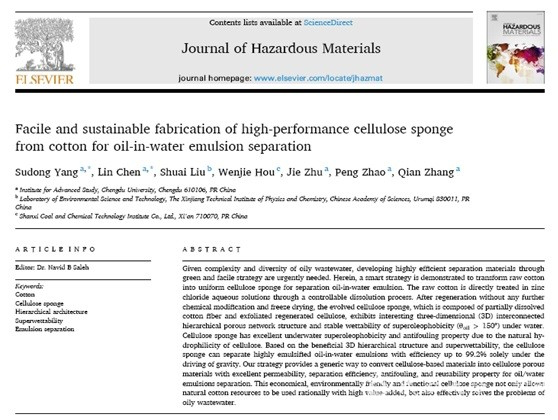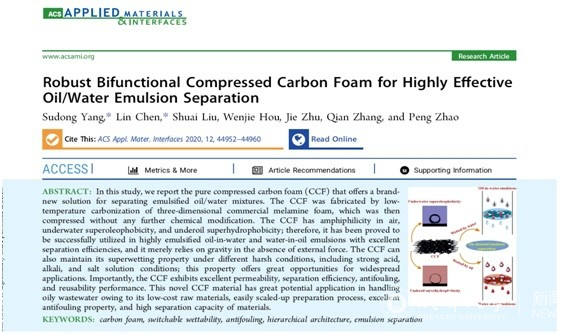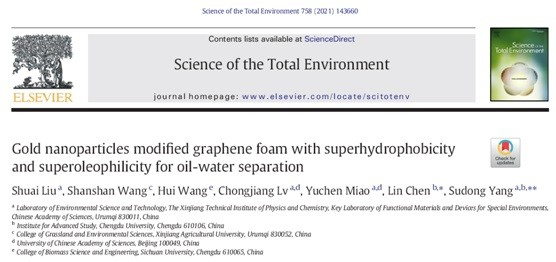Recently, Yang Sudong, a distinguished researcher at Chengdu University, has published two research papers in top journals of environmental sciences and engineering technology as the first author and corresponding author, with Chengdu University as the first unit. The paper entitled "Facile and sustainable fabrication of high-performance cellulose sponge from cotton for oil-in-water emulsion separation" was published in the Journal of hazardous materials (Q1 journal of Chinese Academy of Sciences, impact factor: 9.038), a top journal in environmental sciences, and the paper entitled "Robust bifunctional compressed carbon foam for highly effective oil/water emulsion separation" was published in ACS Applied Materials & Interfaces (Q1 journal of Chinese Academy of Sciences, impact factor: 8.758), a top journal in engineering technology under the American Chemical Society.
In addition, he has published the paper entitled "Gold nanoparticles modified graphene foam with superhydrophobicity and superoleophilicity for oil-water separation" in Science of the Total Environment (Q1 journal of Chinese Academy of Sciences, impact factor: 6.551), a top journal in environmental sciences, as the corresponding author, with Chengdu University as the second unit.

Through dissolution and regeneration, Yang Sudong's research team transformed raw cotton into cellulose sponge with superoleophobicity/underwater superoleophobicity, which showed excellent oil-water separation performance for oil-in-water emulsion containing surfactant. The cellulose sponge obtained by this method not only allows natural cotton resources to be used with high value-added, but also effectively solves the problems of oily wastewater. The study provides guidance and reference for the design and preparation of oil/water emulsion separation materials with high efficiency and low energy consumption.

Yang Sudong's research team also transformed commercial melamine foam into the on-demand multifunctional separation membrane with underwater superoleophobicity/underoil superhydrophobicity through carbonization-compression, which can separate oil-in-water emulsion or water-in-oil emulsion containing surfactant according to the actual needs. This economical, environment-friendly and multifunctional oil-water separation material shows certain potential for large-scale preparation and is expected to be applied in large-scale treatment of oily wastewater.

Yang Sudong's research team designed graphene foam for oil-water separation with superhydrophobic and superoleophilic properties based on bionics. The graphene foam obtained by the method showed excellent absorption performance for oil and organic solvents, and can also be used as the oil-water separation membrane due to high mechanical strength, thereby further widening the application range of graphene foam materials.
News link:
Yang Sudong is a distinguished researcher and master supervisor at the Institute of Advanced Studies, Chengdu University. He graduated from the Nanjing University of Aeronautics and Astronautics with a Ph.D. in 2012, and is devoted to the design and synthesis of new three-dimensional carbon nanocomposites and their application in the environment and catalysis. He has won honorary titles such as Excellent Youth in Xinjiang Uygur Autonomous Region, High-level Introduced Talent in Xinjiang Uygur Autonomous Region, and Young Doctoral Scientific and Technological Talent. He has published over 50 papers, including more than 20 papers in ACS Applied Nano Materials, Nanoscale, Carbon and other academic journals as the first author and corresponding author, and applied 13 invention patents, including 8 authorized patents and 4 assigned patents. He has presided over projects under the National Natural Science Foundation of China and the "Western Light" Talent Training Program of the Chinese Academy of Sciences, as well as the cooperation project with Sinopec Northwest Oilfield Company.